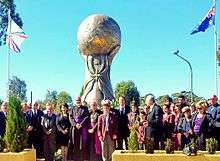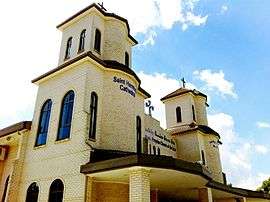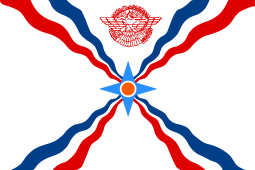Assyrian Australians
 Assyrians standing next to the genocide monument in Western Sydney. | |
| Total population | |
|---|---|
| 30,631 (by ancestry, 2011)[1] | |
| Regions with significant populations | |
|
Sydney, New South Wales Melbourne, Victoria | |
| Languages | |
|
Mostly Assyrian Neo-Aramaic Some Chaldean Neo-Aramaic A few Turoyo speakers Knowledge of English, Arabic and/or Farsi | |
| Religion | |
|
Mainly Assyrian Church of the East, Chaldean Catholic Church, Ancient Church of the East A few Protestants, Evangelicals, Syriac Orthodox and irreligious | |
| Related ethnic groups | |
| Assyrian Americans, British Assyrians, Assyrian Canadians |
Assyrian Australians are Australian citizens of Assyrian descent. According to the 2011 census, 30,631 persons identified themselves as having Assyrian ancestry.[2] The Assyrians have mainly immigrated from, and are indigenous to, northern Iraq, northwest Iran, northeast Syria and southeast Turkey, which are regions that largely correspond with the Assyrian homeland.[3]
Of the 30,000 Assyrians in Australia, 21,000 are members of the Assyrian Church of the East and 9,000 are members of the Chaldean Catholic Church. The City of Fairfield, in Sydney, has the most Assyrians in Australia. 95% of Fairfield’s Iraqi-born population are of Assyrian ancestry. Fairfield LGA also has one of the most predominant Assyrian communities in the diaspora, where one in every ten person would be Assyrian.[4]
During the 1980s war between Iraq and Iran, large numbers of Assyrians fled Iraq and applied for refugee status. In the early 2000s, 5% of Australia’s humanitarian immigrants identified being part of Syriac churches. In May 2013, the Assyrian genocide was recognised by the New South Wales state parliament.[5][6] Assyrian-Australians have established various clubs, social organisation, churches and language schools. Representing only 0.13% of Australia's overall population, Assyrians are considered to be a successful minority group.[7]
History
Early period
The first Assyrians arrived in Australia in the 1950s, to flee from the 1958 revolution in Iraq. By 1965, there were around five Assyrian families and a few individuals living in Sydney. Although around 80% of the arrivals lived in the suburbs of Fairfield LGA in Greater Western Sydney, some Assyrians settled in the eastern suburbs, a region on Sydney's coast. During that period 4,500 Assyrians came from Iraq, 2,500 from Iran and 1,000 from Syria and Lebanon. According to Dinkha Warda, Fairfield was the most popular settlement among Assyrians for reason as follows:[8]
Back in 1966, a small meeting was held between the early settlers to decide the future of Assyrians in this country...In 1966, Fairfield’s developed area went west up to the Cumberland Highway. The majority of those attending the meeting agreed to establish the Assyrian community in Fairfield. The reason was to centralise the development of all the Assyrian social, religious and sporting activities, allowing greater access and participation. If we remained in the Sydney city area, we would have scattered. And so, four or five families purchased fibro houses in Fairfield (including myself), and a few bought blocks of land.
In 1969, following the settlement of Assyrians in the Fairfield area, the Assyrian Australian Association (AAA) was formed. During the 1980s and from the late 1990s, there was an increased level of Assyrian migration to Australia under the family reunion, refugee and humanitarian programs. Reportedly, around 903 Assyrian arrivals were allowed under the Australian Government’s Special Humanitarian Program and the Family Reunion Program.[9]
Early modern history

In 1980, Nineveh Club, a prominent Assyrian club in Edensor Park, Sydney, was established. Built with artificial mud brick, the Club is designed after Assyrian royal palace in Nineveh. The entryway features two winged bull statues containing the body of a lion, the head of an Assyrian king and wings of an eagle. In the mid-1980s, there was a major church split in the Church of the East in Fairfield, which shook and divided the community. The event resulted in legal proceedings over property rights which received national media coverage. The Church of the East in Australia now has two denominations; The ‘old’ (Ancient Church of the East) and the ‘new’ (Assyrian Church of the East).
The Assyrian Sports and Cultural Club opened in 1990, in Fairfield Heights, Sydney. The club acquired liquor and gaming licenses. The club hosted sports events such as The Assyrian Cup and Ethnic Cup soccer tournaments and held functions and activities for the community. It has also supported recently arrived migrants to help them settle in the country and it encouraged education by aiding achievers in the high school certificate.
In 1997, it was reported that, for the Assyrian youth, lack of English skills was the major impediment for gaining employment, school achievement and becoming socially maneuverable in the Australian society. Unfortunately, this is still an ongoing issue, as conveyed by young people through the surveys. For instance, some Fairfield High School Assyrians wanted to go to university but felt hopeless because of their poor English. As such, several Assyrian churches developed a number of youth programs.[10]
Contemporary history

The opening of St Hurmiz Primary School in 2002, in Sydney, was the first time an Assyrian school was established in the international diaspora. In 2006, also in Sydney, St. Narsai Assyrian Christian College was established. It was the first Assyrian high school to be built in the western world. Sydney's Assyrian community assembled in Fairfield to celebrate Iraq qualifying for the Asian Football Cup finals in 2007. More than 7000 people, including Iraqi Arabs, joined in street celebrations around Fairfield on Sunday 29 July 2007 after Iraq won the Asian Cup finals. [11]

On August 2010, a memorial monument for the Assyrian genocide was erected in Bonnyrigg. The statue, being 4.5 meters tall, is designed as a hand of a martyr draped in an Assyrian flag. The memorial is placed in a reserve to be named the Garden of Nineveh. The statue and the name for the reserve were proposed in August 2009. After consultation with the community, Fairfield Council received more than 100 submissions, including some from overseas, and two petitions. The proposal was condemned by the Turkish community. Turkey's consul general to Sydney expressed resentment about the monument, while acknowledging that tragedies had occurred to Assyrians in the period as well as Turks.[12]
On August 2014, more than 6000 Assyrians marched in Belmore Park in Sydney CBD to protest against the treatment of their Assyrian counterparts in Iraq and Syria by ISIS. Many wore T-shirts reading the hashtag #WeAreN, and chanted "we want peace, we want justice" and "save our Christians". They also waved posters, which read "stop genocide against our Christians" and "Stop crimes against humanity". They marched in Elizabeth Street, through the city to Martin Place. Assyrian Community leaders made passionate speeches soliciting the Australian and other international governments to help those being persecuted in the Middle East.[13]
Demographics
Distribution

In Sydney, Assyrians are the leading ethnic group in the Fairfield LGA suburbs of Fairfield, Fairfield Heights and Greenfield Park. Ample amount of Assyrians exist in other suburbs in the Fairfield LGA, such as, Bossley Park, Prairiewood, Wakeley, Wetherill Park, Abbotsbury, Smithfield, Fairfield West, Bonnyrigg Heights, Horsley Park and Cecil Park.[15]
In Liverpool City Council, a LGA that borders Fairfield City, they're found in Cecil Hills, Green Valley, Hoxton Park, Hinchinbrook and Middleton Grange. In the eastern suburbs, they're mainly found in Hillsdale in Bayside Council, albeit in small numbers.
In Melbourne, Assyrians tend to be found in the northwest region, in the suburbs of Broadmeadows, Craigieburn, Meadow Heights, Roxburgh Park and Fawkner.[16]
General statistics
In the 2001 census, 9,520 Fairfield LGA residents stated they were of Assyrian/Chaldean ancestry and 8,879 residents stated they spoke Assyrian at home. The Assyrian-speakers living in NSW were 13,241 at that time. In the 2011 Census, Sydney had 21,678 people of Assyrian descent,[17] and Melbourne had 8,057.[18] Assyrians are the third largest language-group residing in the Fairfield area behind the Arabic and Vietnamese-speakers, respectively.[19]
According to the 2001 census, 29% of Assyrian migrants in Fairfield were usually made up of large families with five members or more. 13-24 year olds made up 18% of the migrating population and 25-54 years were at 57%. 25% of them did not speak English well. 43% of the Assyrians in the Fairfield LGA owned their home, and they generally worked in manufacturing (39%), trade, accommodation, hospitality and transport industries (31%).[20]
Whilst the new arrivals are settling in Fairfield CBD and Fairfield Heights, the pre-mid-1990s arrivals have purchased and/or rented houses in the more affluent suburbs of Fairfield City, such as, Bossley Park, Wetherill Park and Greenfield Park, which are around 6 kilometers (3.7 mi) west from Fairfield CBD. Furthermore, some of the recently arrived Assyrian children have had psychological trauma for the experiences in their countries of origin, which encroached their settlement in Australia.[21]
Culture

Sydney has five prominent Assyrian church buildings; St Mary's Church in Smithfield, St Mary's Assumption Church in Bossley Park and in Fairfield, St Hurmiz Cathedral in Greenfield Park, and St Zaia Cathedral in Middleton Grange. In Melbourne, there are two Assyrian churches available for religious and social activities.[22]
Both Nineveh Club and Cultural Club support and showcase local Assyrian talents, such as singers, actors, musicians, painters and sculptors. The clubs contain reception halls and they usually host singer concerts (including lounge singers), festive parties, weddings, theatrical plays and other forms of social entertainment for the Assyrians in Sydney.[23]

The Assyrians in Sydney lavishly celebrate the Assyrian New Year annually on April 1, in Fairfield Showground in Prairiewood. Thousands attend the New Year festival and it usually features music and theatrical performances, traditional dancers, food stalls and fireworks.[24] Former Australian prime minister Tony Abbott[25] and other politicians such as Chris Bowen, Craig Kelly, Tanya Plibersek, Chris Hayes and former NSW premier Bob Carr have attended the festival and made a speech.[26]
Fairfield's large Assyrian community has had the media describe the suburb as 'Little Iraq' or 'Little Assyria'. Assyrian businesses have opened in Fairfield, mostly in Ware Street and Smart Street, and in Fairfield Heights in The Boulevarde. These businesses include everything from jewelry shops to restaurants and convenient stores, making the area favourite entertainment and shopping hot spot for the Assyrian community.[27]
Sport
Assyrian-Australians, like many other Assyrians from around the world, are mainly fond of soccer, and have established various football clubs in Australia. Fairfield Bulls Soccer Club, based in Sydney, is the most prominent soccer club in the country. It was established in 1971 and it has involved hundreds of kids and teens in different age teams. Legislated by Football NSW, Fairfield Bulls became a standalone club in 2005. The Soccer Club was linked with Nineveh Sports and Community Club. Another conspicuous Assyrian soccer club in Sydney, established in the early 1970s, is the Nineveh Eagles.[28]
Media
Most Assyrian-Australian media is aired on the radio. Assyrian radio has a variety of themes and topics which consist mainly of Assyrian music and interviews with prominent Assyrian individuals, and politics, current events, weather, sport and history. These subjects are usually affiliated with Assyrian people, their culture and homeland.
Radio
- SBS Radio, which airs in Sydney and Melbourne, broadcasts in the Assyrian language every Saturday and Tuesday evenings from 8pm to 9pm.[29]
- 2000FM, a Sydney radio station, airs in the Assyrian language every Monday mornings for three hours, on the frequency of 98.5 FM.[30]
- 2GLF, a community radio station in Sydney's suburb of Liverpool, on the frequency of 89.3 FM, broadcasts a number of Assyrian shows. Nohadra Radio, established in 1998, is the most prominent Assyrian radio show on the station, which airs Sunday nights from 8pm to 10pm.[31]
Notable Assyrian Australians
- Jibrail Kassab - Bishop of the Chaldean Catholic Church.
- Sham Khamis - Plays for Sydney FC in the Australian W-League.
- Ninos Khoshaba - Politician and is a former member of Parliament of New South Wales.
- Cindy Sargon - TV chef and business woman.
- Meelis Zaia - Assyrian Church of the East's metropolitan bishop of Australia, New Zealand and Lebanon.
- Andrew Rohan - A politician, who was a member of the New South Wales Legislative Assembly representing Smithfield for the Liberal Party of Australia from 2011 to 2015.[32]
- Leena Khamis - Plays for Sydney FC in the Australian W-League.
- Mario Shabow - Plays for Western Sydney Wanderers FC in the Hyundai A-League.
- Sue Ismiel - Founder and owner of Nad's.
See also
- Iraqi Australians
- Lebanese Australians
- Syrian Australians
- Jewish Australians
- Armenian Australians
- Iranian Australians
References
- ↑ "Statistics from the 2011 Census" (PDF). The People of NSW. Department of Immigration and Citizenship, Commonwealth of Australia. 2014. Table 13, Ancestry. Retrieved 23 July 2016.
- ↑ Kinarah: Twentieth Anniversary of Assyrian Australian Association 1989, Assyrian Australian Association, Edensor Park.
- ↑ Reforging a Forgotten History: Iraq and the Assyrians in the Twentieth Century By Sargon Donabed
- ↑ Community Relations Commission For a Multicultural NSW 2004, Cultural Harmony. The Next Decade 2002-2012 (White Paper), New South Wales Government, Sydney South.
- ↑ "NSW Parliament formally recognises Assyrian genocide as Smithfield MP Andrew Rohan shares tale of parents' survival". The Daily Telegraph. 14 May 2013. Retrieved 17 March 2015.
- ↑ "Assyrian Genocide Monument Unveiled in Australia". Assyrian International News Agency. 8 July 2010. Archived from the original on 2 September 2010. Retrieved 31 August 2010.
- ↑ Winter, I. 2000, Towards a theorized understanding of family life and social capital, Working paper No. 21, April, Australian Institute of family Studies, Melbourne
- ↑ Assyrian Australian Association & Ettinger House 1997, Settlement Issues of the Assyrian Community, AAA, Sydney.
- ↑ 2004, Australia’s Support for Humanitarian Entrants 2003-04, Commonwealth of Australia, Canberra.
- ↑ "Fairfield's Assyrian Resource Centre has secured $40,000 to fund its renovations". The Daily Telegraph. Retrieved January 31, 2014.
- ↑ Giorgas, D. 2000, ‘Community Formation and Social Capital in Australia’, paper delivered to the 7th Australian Institute of Family Studies Conference, Darling Harbour, Sydney, 25 July.
- ↑ "Turkey protests Assyrian 'genocide' monument". Today's Zaman. Retrieved 26 February 2015.
- ↑ Barker, Anne (3 August 2014). "Australian Iraqi Christians stage protest against religious persecution in their homeland by ISIS". ABC News. Retrieved 25 July 2016.
- ↑ Rubin, M. 2003, ‘Are Kurds a pariah minority?’, Social Research, vol. 70, no. 1, pp. 295-32
- ↑ Deniz, F. 2000, ‘Maintenance and Transformation of Ethnic Identity: the Assyrian Case’, The Assyrian Australian Academic Journal
- ↑ Stone, W. 2001, Measuring Social Capital: Towards a theoretically informed measurement framework for researching social capital in family and community life, Research Paper No. 24, February, Australian Institute of Family Studies, Melbourne.
- ↑ Assyrians in Sydney
- ↑ Assyrians in Melbourne
- ↑ Fairfield City Council 2003, State of the Community Report, Fairfield City Council, Wakeley.
- ↑ Department of Immigration, Multicultural and Indigenous Affairs 2003, Report of the Review of Settlement Services for Migrants and Humanitarian Entrants, Commonwealth of Australia, Canberra.
- ↑ Newton, K. 1997, ‘Social capital and democracy’, American Behavioural Scientist, vol. 40, no. 5, pp. 575-86
- ↑ —1993, Assyrians in Australia, AAA, Sydney
- ↑ Gorgees, P. 2003, ‘The Assyrian Community’s Continued Needs in the Fairfield LGA’, in Checking the Pulse of Fairfield―Conference Report, Fairfield Migrant Resource Centre, Cabramatta.
- ↑ Rizk, Rita (29 March 2016). "Thousands to attend Assyrian New Year festivities in Fairfield". The Daily Telegraph. Retrieved 25 July 2016.
- ↑ McMah, Lauren. "Thousands of people celebrate Assyrian New Year at Fairfield Showground". The Daily Telegraph. Retrieved 25 July 2016.
- ↑ "CELEBRATING THE ASSYRIAN NEW YEAR FESTIVAL 6766 IN SYDNEY". Assyrian Universal Alliance. Retrieved 25 July 2016.
- ↑ "World on a plate". The Sydney Morning Herald. 13 November 2007.
- ↑ Stewart Weeks, M. and Richardson, C. 1998, Social Capital Stories, Centre for Independent Studies, Sydney.
- ↑ "Ethnic radio takes to the air". Sydney Morning Herald. 10 June 1975.
- ↑ "The phenomenon known as 2000FM". 2000FM. 2008. Archived from the original on 19 July 2008. Retrieved 28 July 2016.
- ↑ "Liverpool Council on 2GLF". Liverpool City Council. 2006-06-21. Archived from the original on 23 July 2008. Retrieved 2016-07-28.
- ↑ Green, Antony (4 April 2011). "Smithfield". NSW Votes 2011. Australian Broadcasting Corporation. Retrieved 29 July 2016.
External links
- Assyrian Churches in Australia
- Nohadra Radio
- St. Narsai Assyrian College
- St Hurmizd Assyrian Primary School
- AshurSat
- Fairfield Bulls Soccer Club
- Tony Abbott - Prime Minister of Australia speaks at Assyrian New Year 2015
- Assyrian Radio Schedule, 2GLF
- St Thomas The Apostle Chaldean and Assyrian Catholic Diocese of Australia and New Zealand
- St Zaia Cathedral, Sydney

